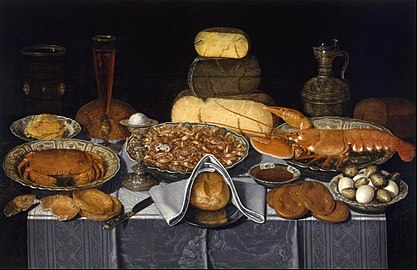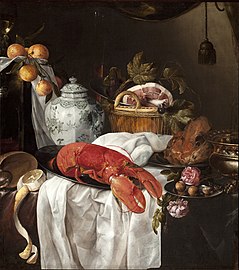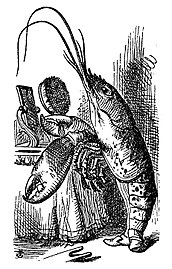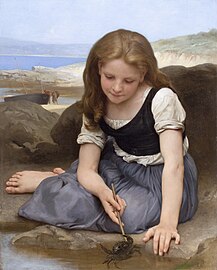
Humans make many uses of arthropods, including as food, in art, in stories, and in mythology and religion. Many of these aspects concern insects, which are important both economically and symbolically, from the work of honeybees to the scarabs of Ancient Egypt. Other arthropods with cultural significance include crustaceans such as crabs, lobsters, and crayfish, which are popular subjects in art, especially still lifes, and arachnids such as spiders and scorpions, whose venom has medical applications. The crab and the scorpion are astrological signs of the zodiac.
Context

The arthropods are a phylum of animals with jointed legs; they include the insects, arachnids such as spiders, myriapods, and crustaceans. Insects play many roles in culture including their direct use as food, in medicine, for dyestuffs, and in science, where the common fruit fly Drosophila melanogaster serves as a model organism for work in genetics and developmental biology.
As food

Crustaceans are an important source of food, providing nearly 10,700,000 tons in 2007; the vast majority of this output is of decapods: crabs, lobsters, shrimps, crayfish, and prawns. Over 60% by weight of all crustaceans caught for consumption are shrimp and prawns, and nearly 80% is produced in Asia, with China alone producing nearly half the world's total. Non-decapod crustaceans are not widely consumed, with only 118,000 tons of krill being caught, despite krill having one of the greatest biomasses on the planet.
Crabs make up 20% of all marine crustaceans caught, farmed, and consumed worldwide, amounting to 1.5 million tonnes annually. One species, Portunus trituberculatus, accounts for one-fifth of that total. Other commercially important taxa include Portunus pelagicus, several species in the genus Chionoecetes, the blue crab (Callinectes sapidus), Charybdis spp., Cancer pagurus, the Dungeness crab (Metacarcinus magister), and Scylla serrata, each of which yields more than 20,000 tonnes annually.
Lobsters are caught using baited, one-way traps with a colour-coded marker buoy to mark cages. Lobster is fished in water between 2 and 900 metres (1 and 500 fathoms), although some lobsters live at 3,700 metres (2,000 fathoms). Cages are of plastic-coated galvanised steel or wood. A lobster fisher may tend as many as 2,000 traps. Around 2000, owing to overfishing and high demand, lobster aquaculture expanded. As of 2008, no lobster aquaculture operation had achieved commercial success, mainly because lobsters eat each other (cannibalism) and the growth of the species is slow.
Eighty percent of the world's nations eat insects of 1,000 to 2,000 species. Insects used as food around the world include crickets, cicadas, grasshoppers, ants, various beetle grubs (such as mealworms, the larvae of the darkling beetle), and various species of caterpillar (such as bamboo worms, mopani worms, silkworms and waxworms).

Arachnids such as spiders, scorpions, or mite are also used as food worldwide. Fried tarantula spiders are considered a delicacy in Cambodia, and by the Piaroa Indians of southern Venezuela – provided the highly irritant hairs, the spiders' main defence system, are removed first.
In science and engineering
Insects feature in a variety of ways in biomimicry, where for example the cooling system of termite mounds has been imitated in architecture.
Spider venoms may be a less polluting alternative to conventional pesticides, as they are deadly to insects but the great majority are harmless to vertebrates. Australian funnel web spiders are a promising source, as most of the world's insect pests have had no opportunity to develop any immunity to their venom, and funnel web spiders thrive in captivity and are easy to "milk". It may be possible to target specific pests by engineering genes for the production of spider toxins into viruses that infect species such as cotton bollworms.
Because spider silk is both light and strong, attempts are being made to produce it in goats' milk and in the leaves of plants, by means of genetic engineering.
In medicine
The Ch'ol Maya use a beverage created from the tarantula Brachypelma vagans for a condition they term 'tarantula wind', the symptoms of which include chest pain, asthma and coughing. The peptide GsMtx-4, found in the venom, has been studied for possible use in cardiac arrhythmia, muscular dystrophy, and glioma. Possible medical uses for other spider venoms have been investigated for the treatment of cardiac arrhythmia, Alzheimer's disease, strokes, and erectile dysfunction.
In folklore, mythology and religion
Further information: Insects in mythology and Insects in religion

Arthropods appear in folklore, in mythology, and in religion. Since Insects in mythology and in religion are covered elsewhere, this section focuses on other arthropods.
Both the constellation Cancer and the astrological sign Cancer are named after the crab, and depicted as a crab. William Parsons, 3rd Earl of Rosse drew the Crab Nebula in 1848 and noticed its similarity to the animal; the Crab pulsar lies at the centre of the nebula. The Moche people of ancient Peru worshipped nature, especially the sea, and often depicted crabs in their art. In Greek mythology, Karkinos was a crab that came to the aid of the Lernaean Hydra as it battled Heracles. One of Rudyard Kipling's Just So Stories, The Crab that Played with the Sea, tells the story of a gigantic crab who made the waters of the sea go up and down, like the tides.
In the Japanese fairy tale "My Lord Bag of Rice", the warrior Fujiwara no Hidesato slays a giant centipede, Ōmukade, to help a dragon princess.

Spiders have been depicted in stories, mythologies and the arts of many cultures for centuries. They have symbolized patience due to their hunting technique of setting webs and waiting for prey, as well as mischief and malice due to their venomous bites. The Italian tarantella is a dance supposedly to rid the young woman of the lustful effects of a bite by the tarantula wolf spider, Lycosa tarantula. Web-spinning caused the association of the spider with creation myths, as they seem to produce their own worlds. Dreamcatchers are depictions of spiderwebs. The Moche people of ancient Peru worshipped nature, emphasising animals and often depicting spiders in their art.
The scorpion appeared as the astrological sign Scorpio, in the twelve signs of the Zodiac, created by Babylonian astronomers during the Chaldean period, around 600 BC. In South Africa and South Asia, the scorpion is a significant animal culturally, appearing as a motif in art, especially in Islamic art in the Middle East. A scorpion motif is often woven into Turkish kilim flatweave carpets, for protection from their sting. The scorpion is perceived both as an embodiment of evil and a protective force that counters evil, such as a dervish's powers to combat evil. In another context, the scorpion portrays human sexuality. Scorpions are used in folk medicine in South Asia especially in antidotes for scorpion stings. In ancient Egypt the goddess Serket was often depicted as a scorpion, one of several goddesses who protected the Pharaoh.
In art, literature, and music
Insects feature in art, in literature, in film, and in music.
The "Lobster Quadrille", also known as "The Mock Turtle's Song", is a song recited by the Mock Turtle in Alice's Adventures in Wonderland, chapters 9 and 10, accompanied by a dance.
The surrealist artist Salvador Dalí created a sculpture called Lobster Telephone with the crustacean in place of the traditional handset, resting in the cradle above the dial. The Surrealist filmmaker Luis Buñuel used scorpions in his 1930 classic L'Age d'or (The Golden Age).
-
 Crustaceans in Roman mosaic in the 'House of the Dancing Faun', Pompeii (by 79 AD)
Crustaceans in Roman mosaic in the 'House of the Dancing Faun', Pompeii (by 79 AD)
-
 Still Life with Crab, Shrimps and Lobster, Clara Peeters, c. 1600
Still Life with Crab, Shrimps and Lobster, Clara Peeters, c. 1600
-
 Fish, oysters, a crab and a lobster with cats..., Jan Fyt, c. 1650
Fish, oysters, a crab and a lobster with cats..., Jan Fyt, c. 1650
-
 Pronk Still life with lobster, Jasper Geeraerts, 1650–1654
Pronk Still life with lobster, Jasper Geeraerts, 1650–1654
-
 Lewis Carroll's lobster, drawn by Sir John Tenniel, 1869
Lewis Carroll's lobster, drawn by Sir John Tenniel, 1869
-
 Le Crabe by William-Adolphe Bouguereau, 1869
Le Crabe by William-Adolphe Bouguereau, 1869
-
 The Lobster by Samuel Peploe, c. 1903
The Lobster by Samuel Peploe, c. 1903
-
 Illustration from The Water-Babies by Charles Kingsley, illustrated by Warwick Goble (d. 1943)
Illustration from The Water-Babies by Charles Kingsley, illustrated by Warwick Goble (d. 1943)
-
Maman sculpture by Louise Bourgeois at the National Gallery of Canada, 1999
See also
References
- Ortega-Hernández, J. (2016). "Making sense of 'lower' and 'upper' stem-group Euarthropoda, with comments on the strict use of the name Arthropoda von Siebold, 1848". Biological Reviews. 91 (1): 255–273. doi:10.1111/brv.12168. PMID 25528950. S2CID 7751936.
- Meyer-Rochow V.B., Nonaka K., Boulidam S. (2008). "More feared than revered: Insects and their impacts on human societies (with specific data on the importance of entomophagy in a Laotian setting". Entomologie Heute. 20: 3–25.
{{cite journal}}: CS1 maint: multiple names: authors list (link) - Chakravorty J., Ghosh S., Meyer-Rochow V.B. (2011). "Practices of entomophagy and entomotherapy by members of the Nyishi and Galo tribes, two ethnic groups of the state of Arunachal Pradesh (North-East India)". Journal of Ethnobiology and Ethnomedicine. 7: 5. doi:10.1186/1746-4269-7-5. PMC 3031207. PMID 21235790.
{{cite journal}}: CS1 maint: multiple names: authors list (link) - "Cochineal and Carmine". Major colourants and dyestuffs, mainly produced in horticultural systems. FAO. Retrieved June 16, 2015.
- Pierce, BA (2006). Genetics: A Conceptual Approach (2nd ed.). New York: W.H. Freeman and Company. p. 87. ISBN 978-0-7167-8881-2.
- "FIGIS: Global Production Statistics 1950–2007". Food and Agriculture Organization. Retrieved February 24, 2010.
- Steven Nicol; Yoshinari Endo (1997). Krill Fisheries of the World. Fisheries Technical Paper. Vol. 367. Food and Agriculture Organization. ISBN 978-92-5-104012-6.
- "Global Capture Production 1950-2004". Food and Agriculture Organization. Archived from the original on January 23, 2016. Retrieved August 26, 2006.
- Asbjørn Drengstig; Tormod Drengstig & Tore S. Kristiansen. "Recent development on lobster farming in Norway – prospects and possibilities". UWPhoto ANS. Archived from the original on 2003-10-04.
- "Riddles, Trivia and More". Gulf of Maine Research Institute. February 24, 2012. Retrieved July 23, 2012.
- Carrington, Damian (1 August 2010). "Insects could be the key to meeting food needs of growing global population". The Guardian.
- Ramos-Elorduy, Julieta (2009). "Anthropo-Entomophagy: Cultures, Evolution And Sustainability". Entomological Research. 39 (5): 271–288. doi:10.1111/j.1748-5967.2009.00238.x. S2CID 84739253.
- Global Steak - Demain nos enfants mangeront des criquets (2010 French documentary)
- E.M. Costa-Neto, N.T. Grabowski (27 November 2020): Edible arachnids and myriapods worldwide – updated list, nutritional profile and food hygiene implications. In: Journal of Insects as Food and Feed: 0 (0), pp. 1-20. doi: https://doi.org/10.3920/JIFF2020.0046
- Ray, N. (2002). Lonely Planet Cambodia. Lonely Planet Publications. p. 308. ISBN 978-1-74059-111-9.
- Weil, C. (2006). Fierce Food. Plume. ISBN 978-0-452-28700-6. Archived from the original on 2011-05-11. Retrieved 2008-10-03.
- "Termite research". esf.edu. Archived from the original on 14 August 2012. Retrieved 23 July 2012.
- "Spider Venom Could Yield Eco-Friendly Insecticides". National Science Foundation (USA). Retrieved 2008-10-11.
- Hinman, M. B.; Jones J. A. & Lewis, R. W. (2000). "Synthetic spider silk: a modular fiber" (PDF). Trends in Biotechnology. 18 (9): 374–9. CiteSeerX 10.1.1.682.313. doi:10.1016/S0167-7799(00)01481-5. PMID 10942961. Archived from the original (PDF) on 2008-12-16. Retrieved 2016-07-03.
- Menassa, R.; Zhu, H.; Karatzas, C. N.; Lazaris, A.; Richman, A.; Brandle, J. (2004). "Spider dragline silk proteins in transgenic tobacco leaves: accumulation and field production". Plant Biotechnology Journal. 2 (5): 431–8. doi:10.1111/j.1467-7652.2004.00087.x. PMID 17168889.
- M'Rabet, Salima Machkour; Hénaut, Yann; Winterton, Peter; Rojo, Roberto (2011). "A case of zootherapy with the tarantula Brachypelma vagans Ausserer, 1875 in traditional medicine of the Chol Mayan ethnic group in Mexico". Journal of Ethnobiology and Ethnomedicine. 7: 12. doi:10.1186/1746-4269-7-12. PMC 3072308. PMID 21450096.
- Novak, K. (2001). "Spider venom helps hearts keep their rhythm". Nature Medicine. 7 (155): 155. doi:10.1038/84588. PMID 11175840.
- Lewis, R. J. & Garcia, M. L. (2003). "Therapeutic potential of venom peptides". Nature Reviews Drug Discovery. 2 (10): 790–802. doi:10.1038/nrd1197. PMID 14526382.
- Bogin, O. (Spring 2005). "Venom Peptides and their Mimetics as Potential Drugs" (PDF). Modulator (19). Archived from the original (PDF) on 2008-12-09. Retrieved 2016-07-03.
- Andrade E.; Villanova F.; Borra P.; Leite, Katia; Troncone, Lanfranco; Cortez, Italo; Messina, Leonardo; Paranhos, Mario; Claro, Joaquim; Srougi, Miguel (2008). "Penile erection induced in vivo by a purified toxin from the Brazilian spider Phoneutria nigriventer". British Journal of Urology International. 102 (7): 835–7. doi:10.1111/j.1464-410X.2008.07762.x. PMID 18537953.
- Gullan, P. J.; Cranston, P. S. (2009). The Insects: An Outline of Entomology. John Wiley & Sons. pp. 9–13. ISBN 978-1-4051-4457-5.
- Balée William (2000). "Antiquity of Traditional Ethnobiological Knowledge in Amazonia: a Tupí–Guaraní Family and Time". Ethnohistory. 47 (2): 399–422. doi:10.1215/00141801-47-2-399. S2CID 162813070.
- B. B. Rossi (1969). The Crab Nebula: Ancient History and Recent Discoveries. Center for Space Research, Massachusetts Institute of Technology. CSR-P-69-27.
- Elizabeth Benson (1972). The Mochica: A Culture of Peru. New York, NY: Praeger Press. ISBN 978-0-500-72001-1.
- Katherine Berrin; Larco Museum (1997). The Spirit of Ancient Peru:Treasures from the Museo Arqueológico Rafael Larco Herrera. New York: Thames and Hudson. p. 216. ISBN 978-0-500-01802-6.
- Kipling, Rudyard (1902). "The Crab that Played with the Sea". Just So Stories. Macmillan.
- de Visser, D. M. (1913). The Dragon in China and Japan. J. Müller. pp. 191–192. Archived from the original on 2016-12-25. Retrieved 2018-03-09.
- De Vos, Gail (1996). Tales, Rumors, and Gossip: Exploring Contemporary Folk Literature in Grades 7–12. Libraries Unlimited. p. 186. ISBN 978-1-56308-190-3.
- Garai, Jana (1973). The Book of Symbols. New York: Simon & Schuster. ISBN 978-0-671-21773-0.
- Ettlinger, Ellen (1965). Review of "La Tarantella Napoletana" by Renato Penna (Rivista di Etnografia), Man, Vol. 65. (Sep. – Oct., 1965), p. 176.
- De Laguna, Frederica (2002). American Anthropology: Papers from the American Anthropologist. University of Nebraska Press. p. 455. ISBN 978-0-8032-8280-3.
- Benson, Elizabeth. The Mochica: A Culture of Peru. New York: Praeger Press. 1972.
- Berrin, Katherine & Larco Museum. The Spirit of Ancient Peru: Treasures from the Museo Arqueológico Rafael Larco Herrera. New York: Thames and Hudson, 1997.
- Gary A. Polis (1990). The Biology of Scorpions. Stanford University Press. p. 462. ISBN 978-0-8047-1249-1.
- ^ Jürgen Wasim Frembgen (2004). "The scorpion in Muslim folklore" (PDF). Asian Folklore Studies. 63 (1): 95–123.
- Erbek, Güran (1998). Kilim Catalogue No. 1. May Selçuk A. S. Edition=1st.
- Mark, Joshua J. "Serket". World History Encyclopedia. Retrieved 4 July 2016.
- Gough, Andrew. "The Bee Part 2 Beewildered". Retrieved 23 July 2012.
- "Ladybug Ladybug (1963)". IMDb. 23 December 1963. Retrieved 23 July 2012.
- "The Lobster-quadrille". The Literature Network. Retrieved 3 July 2016.
- Lobster Telephone in the collection of Tate Liverpool, London. Accessed 27-01-2010.
- Allen S. Weiss (1996). "Between the sign of the scorpion and the sign of the cross: L'Age d'or". In Rudolf E. Kuenzli (ed.). Dada and Surrealist Film. MIT Press. pp. 159–175. ISBN 978-0-262-61121-3.